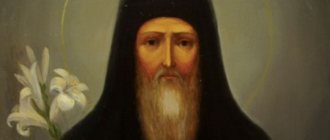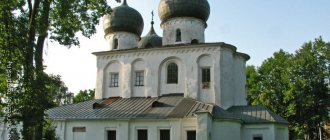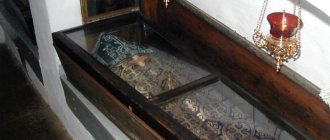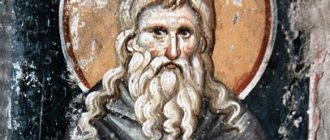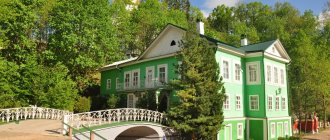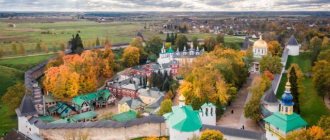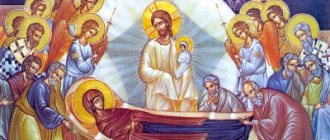| St. Alypiy Pechersky. Icon (19th century) at the shrine of the relics of the saint |
Alypius of Pechersk
(+ c. 1114), icon painter, hieromonk, venerable Commemoration on August 17, in the Cathedral of the Venerable Fathers of the Kiev-Pechersk Near Caves and in the Cathedral of all the Venerable Fathers of the Kiev-Pechersk
One of the first and best Russian icon painters, tonsured by St. Nikon, from a young age he labored in the Kiev Pechersk Monastery. He studied icon painting from Greek masters, who since 1083 decorated the Pechersk Church in honor of the Dormition of the Blessed Virgin Mary. The Monk Alypius painted icons for free. If he found out that the images in some temple were dilapidated, he took them to himself and corrected them free of charge. If it happened that he was paid for his work, the monk spent one part on purchasing materials for icon painting, distributed the second to the poor, and kept only the third for himself.
The Monk Alypius was never idle and abandoned icon painting only for the sake of Divine service. He was ordained as a hieromonk and was known for his gift of miracles during his lifetime: for example, he healed a Kievite who suffered from leprosy and rotting of the body, anointing the wounds of the patient with paints prepared for painting icons.
Many icons painted by the Monk Alypius became famous as miraculous. There are some known cases when the angels of God helped him in the holy work of writing images. This was the case with the wonderfully painted images for the Kyiv church on Podol, of which the most famous is the Vladimir-Rostov Icon of the Mother of God (see more details). Another time, an angel painted an icon in honor of the Dormition of the Most Holy Theotokos, when the Monk Alypius lay in his dying illness. The same angel received the soul of the saint, who died on August 17, no later than 1114.
| St. Alypiy Pechersky. Fragment of the icon “Tree of the Pechersk Saints” (1660s) from the Church of the Annunciation in Uglich. Uglich Museum |
Saint Alypius was buried in the Near Caves. On the right hand of the monk, the first three fingers are folded completely equally, and the last two are bent to the palm - in such a prayerful overshadowing of himself with the sign of the cross, he died. One of the icons he painted - the Most Holy Theotokos with the Infant Savior and the forthcoming Saints Anthony and Theodosius of Pechersk, called Svenskaya, is now kept in the State Tretyakov Gallery.
Alypiy Pechersky, biography in icons
All information about the life of the holy icon painter is connected with the images of saints he painted. History has not preserved the exact date of his birth and information about his parents. The first information about Alipia dates back to the time of Prince Vsevolod Yaroslavovich.
Venerable Alypius of Pechersk
At the request of the Reverend Abbot Nikon, to whom the Reverend Fathers Anthony and Theodosius, who had died 10 years ago, appeared and offered to invite icon painters from Greece, the restoration of the Pechersk Church began, and in parallel, the teaching of icon painting in Rus'.
About icons:
- Icon veneration in Orthodoxy
- Who paints icons for the church
- Choosing an icon-intercessor
Alipius's parents, whose name has not been preserved by history, seeing their son's ability to draw, begged the Greek masters to take him in for training. The young apprentice witnessed the amazing appearance of the holy image of the Most Pure Mother of God while decorating the altar in the Pechersk Church with paintings and mosaics.
The face of the Mother of God shone with the brightest light, and a snow-white dove flew out of her mouth, it flew across the entire temple and flew into the Mouth of the Savior, depicted on the icon at the top of the church.
The young man, enveloped in the grace of the Holy Spirit, helped the teachers with joy and reverence. At the end of the work, when the church sparkled with new consecrated images, the Greeks returned to their homeland, Blessed Alypius decides to become a monk, for which he was blessed by the Venerable Abbot Nikon.
The icon painter, gifted by God, first saw future creations within himself; he seemed to feel the souls of the saints depicted, embodying them on the icons. On the holy faces created by the blessed artist, one can feel the spiritual image of the depicted saint, conveyed very skillfully.
Working for the Glory of God
The skilled craftsman did not see his life outside of painting icons; he worked not for money, but for the glory of the Lord, distributing his creations free of charge among the priesthood, brethren and ordinary prayer books coming to church. The blessed icon painter treated the ancient faces of saints with great trepidation, happily restoring them without demanding payment for it.
Idleness was unfamiliar to the saint; if he did not create, he was in worship. The fame of the ordained hieromonk Alipiya, who possessed miraculous powers, spread not only throughout Kyiv, but also far beyond its borders. Often customers left money for the work, which the saint divided into three parts:
- for materials for work;
- for the needs of the monastery;
- for the poor.
Alypiy of Pechersk paints the image of the Virgin Mary
In those days when there were no orders, the blessed master wrote for his own pleasure, then he gave his works to those who donated gold and silver to decorate the divine faces. Working during the day, the saint stayed awake and prayed at night, often fasting. He left icon painting only for the sake of prayer services, which he never missed.
Miracles of the Holy Priest
The saint's purity, virtue, patience and other godly qualities were noticed by the abbot of the monastery, and the Monk Alypius was elevated to priesthood. The monks compare him to a candle in the lamp of God, he became an example to follow, demonstrating the beauty of virtues. The Lord gave the blessed one the gift of working miracles, healing the sick and helping disadvantaged people.
Healing a leper
This incident remains in the history of the Pechersk Church and is passed down from generation to generation. A rich Kievite suffered from leprosy, he visited all the healers, turned to wizards and pagans, but his condition only worsened. Having heard advice from friends to go and venerate the holy images in the Pechersk Monastery, the leprosy patient reluctantly agreed.
The abbot himself met the sick man, gave him holy well water to drink, and washed his face with it. What happened next filled everyone with fear. Wounds began to open on the leper’s body, pus flowed in streams, filling everything around with a fetid stench. In despair, with a feeling of shame and disgrace, the Kiev resident retired to his house and locked himself in it for a long time in anticipation of death.
Time passed, the leper began to pray, cry out to God and decided to return to the monastery and repent of his sins. The Lord granted a meeting between the sick and blessed Alipius, who told the leper about the power of the blood of Jesus, repentance and forgiveness.
To heal from leprosy, the blessed one anointed the sick man with paints, took him to the temple for communion, after which he told him to wash himself with the water intended for washing the priests who had received the Holy Sacraments. A miracle was revealed immediately, the leprosy fell off in scabs from the patient, and he returned home in health.
Icon of Saint Alypius of Pechersk
Like Jesus who healed the lepers (Matthew 8:4), Alipius ordered the man freed from leprosy to appear to the priest and bring gifts of thanksgiving to God. In memory of the healing of his great-grandfather, as a sign of gratitude to God, a descendant of this Kiev resident donated gold for the forging of the sacred ark.
Like Christ, the blessed icon painter anointed the sick man with paints, like Jesus’ eyes with mud (John 9:6-7), then washed him with water for physical healing and spiritual insight, so that the blindness of the soul would disappear.
After healing the patient, the icon painter addressed everyone present with God’s word, emphasizing that in the world they want to serve two masters, but God is a jealous man, He does not give His glory to anyone (Matthew 6:24).
A story with seven icons
Knowing the saint’s attitude towards money, two monks decided to take advantage of this when a Kiev acquaintance approached them with a request for the Holy Father to paint icons for the newly built church. The pious husband handed over silver and boards for painting holy images. Time passed, the customer asked about the result, and the scammers who appropriated the silver said that the icon painter said to give more money.
The Kievite did not argue and paid a second, third time, just to receive the icons painted by the saint, for he knew that many of the holy images previously transferred to churches had miraculous powers. After some time, the worthless monks declared that the icon painter had taken the money but did not want to paint.
The patience of the Christ-loving husband came to an end, he took a squad and went to the monastery with a complaint to the abbot. Alypiy, who was summoned, was very surprised by the news and said that he had not heard anything about this order. The monks confirmed that they had seen the boards in the monastery premises, they went to bring them.
It is difficult to convey delight, surprise, awe from the miracle seen, revealed in skillfully painted holy images. All those present fell to their knees in prayer of thanksgiving to God, seeing the icons of the Mother of God and the Savior, painted by the hand of an angel.
Copy from an ancient icon painted by Alypiy Pechersky
The scammers who arrived, not seeing the miraculously painted images of saints, immediately began accusing Alypius of deception and embezzlement of money. The angry abbot pointed to the icons painted by the Creator himself and said that they were witnesses to the innocence of the icon painter. The deceivers fell to their knees, admitted their sin, but were expelled from the monastery.
Having sinned once, he cannot stop in his anger unless he repents.
So, the monks expelled from the monastery began to walk around the city and spread blasphemy that they had painted the icons, and the blessed master deceived everyone, attributing the work to the Holy Spirit. The townspeople went to church to see miraculous images. The Lord Himself stood up to defend the anointed master. As a result of the fire that occurred in Podol, the church in which the shrines were kept burned down, however, seven intact icons were found on the ashes.
Prince Vladimir Monomakh heard about the miracle performed by God to justify Alypius, he came to the site of the burnt church, chose an icon of the Mother of God and sent it to Rostov, to the temple he built. Fires and destruction occurred several times in the Rostov church, but the face of the Holy Mother of God remained unharmed, confirming the virtuous life of the Monk Saint Alypius of Pechersk.
Great Old Russian icon painters: St. Alypiy Pechersky, Theophanes the Greek.
⇐ PreviousPage 9 of 17Next ⇒
Great Old Russian icon painters: St. Alypiy Pechersky, Theophanes the Greek.
Name of St. Alipia (Alimpia) of Pechersk stands first among Russian icon painters. He is called the founder of Russian icon painters and reveals a number of remarkable Russian masters.
The monk lived at the end of the 11th and beginning of the 12th centuries. Presumably, his homeland was Kyiv. The parents saw in their son a penchant for fine art and sent him to the Greek masters who arrived in Kiev to decorate the Assumption Church of the Kiev-Pechersk Monastery. (“This Alimpiy, in the days of the blessed prince of Kiev Vsevolod Yaroslavich, was betrayed by his parents to the Greek icon painters who came (1084 .) for the decoration of the holy Pechersk churches for the teaching of icon images" Patericon of the Kiev Pechersk Monastery. - Kyiv, 1863, l. 147) Soon young Alypius worked with his teachers, helping them. Humility, hard work and non-covetousness were his characteristic features. After completing the painting work on the temple of St. Alypius takes monastic vows at the Kiev Pechersk Monastery from St. Nikon.
The young monk icon painter was distinguished by his exceptional hard work and love for his holy work. Developing your talent, St. Alypius feared idleness most of all. The saint's unselfishness and charity were combined with humility, purity, patience, and love. (The kindness of the heart of St. Alypius is also reflected in his service - “Never have you been upset at those who insult you, nor have you repaid evil for evil.” Troparion 8 canon ) For the high Christian qualities of St. Alypius was ordained a hieromonk.
The godly life of the righteous man attracted people to him asking for prayer for them. The life describes cases of the saint working miracles, the miraculous painting of the image of the Savior, the Mother of God, and saints. (Especially remarkable were the 7 great icons that St. Alypius painted, commissioned by a Kievite for the wooden church he built in Podol. They were painted “very cunningly”; after the fire preserved unharmed in the temple. - Macarius (Bulgakov), Metropolitan of Moscow. History of the Russian Church.) The icon of the “Assumption of the Mother of God” was miraculously painted when the monk was already on his deathbed. When asked by the abbot who wrote the icon, the monk replied, “An angel wrote it, and the same is to come, even if I am taken to death.” These were the reverend's last words. The righteous death of St. Alipia occurred on August 17, 1114
., one day after the feast of the Dormition of the Virgin Mary. The saint's memory is celebrated on August 17/30.
Sources indicate several icons that belong to the brush of St. Alypia: icon of the “Vladimir Mother of God”
from the Rostov Cathedral, (This is one of the first copies of the icon of the “Vladimir Mother of God”. According to legend, it was written by the Angel himself for St. Alypius. Brought to Rostov by Prince Vladimir Monomakh. It was located in the iconostasis of the Assumption Cathedral. The icon died at the hands of an inexperienced “restorer” at the beginning XIX century) the icon of
the “Mother of God of Pechersk
” from the Svensky Monastery of the city of Bryansk and the icon
“Tsar to the Tsar”
or “Present Queen” from the Assumption Cathedral of the Moscow Kremlin. (According to the research of specialists, this icon dates back to the 14th century. It is known that the icon was renewed in the 18th century. icon painter K. Ulanov)
Theophanes the Greek.
The works of Theophanes the Greek and others. Andrei (Rublev) puts an imprint on all church art of the 15th century, during which it reaches the pinnacle of its artistic expression. This is the classical era of Russian icon painting.
The Byzantine metropolitan artist arrived in Novgorod as a mature master, having already painted many churches in Constantinople, Chalcedon and Galata (altars of Constantinople), Cafe (in Crimea), and possibly some other cities. According to some reports, before his arrival in Novgorod, he painted at least 40 churches. He is called “a glorious sage, a highly skilled philosopher.” As noted by Rev. Epiphanius the Wise, Theophanes did not turn to samples at all, but wrote while reflecting and talking with those who came to see the birth of his creations.
Theophanes the Greek was first mentioned in Novgorod in 1378 during the painting of the Church of the Transfiguration. Great creative energy allowed Feofan to work on the paintings of several temples in a short time and have many followers of his work.
Having left a bright mark on Novgorod art, Feofan the Greek soon found himself in North-Eastern Rus', in Nizhny Novgorod. The master participates in the creation of frescoes and iconostasis in the Spassky Cathedral and the Church of the Annunciation Monastery. It is possible that in 1392 Feofan painted the cathedral in Kolomna, which was built by Dmitry Donskoy. In addition to Kolomna, it is possible that Theophanes the Greek worked in the Transfiguration Cathedral of Pereslavl-Zalessky around 1403.
The appearance of the famous master in Moscow is noted in the chronicle in 1395, when he, together with Simeon Cherny, painted the Church of the Nativity of the Virgin Mary, the Archangel Cathedral (1399) and a number of other churches (It is also known that Feofan painted the walls of the stone chambers of Grand Duke Vladimir Andreevich "unknown painting")
Theophanes the Greek was one of the leaders of the hesychasm movement in Rus'. According to Epiphanius the Wise, in his work “he discerned the distant and reasonable with his mind, with his sensual eyes he saw the goodness of reason,” that is, with his mind he comprehended the distant spiritual, for with enlightened, spiritualized sensual eyes he saw spiritual beauty.
The main works that have survived to this day, undoubtedly belonging to the brush of the great master, are now in Novgorod, in the iconostasis of the Annunciation Cathedral of the Kremlin
(1405). The year of death of Theophanes the Greek is unknown, the chronicles do not mention him after 1405. His creativity and enormous original talent had a huge influence on Russian church culture. It gave a vivid example of the creativity of many masters.
Among the first and greatest artists of the era of hesychasm is Theophanes the Greek. He arrived in Rus' at the end of the 14th century, already a famous master. Epiphanius the Wise reports that the Greek painted forty churches in Constantinople, Galata, Cafe and other cities. Theophan's first known work in Rus' is the painting of the Church of the Transfiguration on Ilyin Street in Novgorod (1378). The consecration of this temple in the name of the Transfiguration of the Lord became the basis of the program for its painting. Unfortunately, the frescoes are poorly preserved; only small fragments have survived to this day. But even in such a fragmentary form, the work of Theophanes the Greek amazes with its amazing pictorial skill, depth and originality of the master’s imaginative thinking. As soon as you cross the threshold of a small but very elongated temple, you are literally stopped by the gaze of Christ the Pantocrator, depicted in the dome: lightning seems to sparkle from his wide-open eyes. This image makes us recall the words from Holy Scripture: “Our God is a consuming fire” (Heb. 12.29) or “I have come to bring down fire on the earth” (Luke 12.49). The image of Pantocrator dominates the space of the temple, and it provides the key to the figurative reading of the entire ensemble. For Theophanes, as for every hesychast, God is first of all Light, but this Light appears here in the hypostasis of fire. The world is tested by this fire, the world is judged by this fire, this fire burns all untruth, dividing creation into light and darkness, heavenly and earthly, spiritual and mental, created and uncreated. Fire is the sword that pierces the flesh of the world (Heb. 4.12). Hence the pictorial language of Feofan - he reduces the entire palette to a kind of dichotomy: he writes everything with two colors - ocher and white; we see lightning flashes of white glare (light, fire) flashing on an ocher-clay background (the color of earth). Everything is written incredibly energetically, with some exaggerated effects, with increased semantic accents.
There has been a lot of discussion in the research literature about the unusual coloristic solution of Feofanovskaya painting. Some scientists have put forward the version of a fire that discolored the painting. But archaeologists found no traces of the fire, and restorers confirmed that the paint layer was like this originally. In addition, familiarity with hesychast painting in other countries, for example the Balkan region, shows that such a case is not isolated. And the figurative structure of the Feofanovskaya painting speaks of this. that monochrome was chosen by the master quite consciously, as a metaphorical language. The color minimalism of this painting can be correlated by analogy with the rejection of verbosity in prayer, which was professed by the hesychasts; By reducing their rule to a few words of the Jesus Prayer, the hesychasts achieved incredible concentration of thought and spirit. Theophanes the Greek also achieves the same concentration.
Of the entire ensemble of the Church of the Transfiguration, the dome with the drum turned out to be the most preserved. Let's take a closer look at it. In the skufya around Christ Pantocrator, angelic forces are depicted, below, in the drum - prophets. The selection of prophets is unusual, like everything in Theophan, which allows one to “read” his plan. Here are depicted the so-called pre-Flood prophets, that is, the forefathers who lived before the Flood, before the first Testament that God concluded with humanity in the person of Noah. Thus, we see: Adam, Abel, Seth, Enoch, Noah. Of the later prophets, only Elijah and John the Baptist are included in this series. The idea is very transparent: the first world perished from water, the second will perish from fire, salvation in the first catastrophe of Noah in the ark is the proclamation of the Church. The fiery prophet Elijah announced this divine fire and himself ascended to heaven in a fiery chariot (2 Kings 1-2). The last prophet of the Old Testament, John the Baptist, preached that Christ would baptize with the Holy Spirit and fire (Matthew 3.11).
The paintings in the small chapel dedicated to the Holy Trinity are relatively well preserved - this is a small room in the choir intended for individual prayer. The program for this painting was the contemplation of the Holy Trinity by the ascetics. On the eastern wall is written the image “The Appearance of Three Angels” (“Hospitality of Abraham”). At the bottom of the fresco, Abraham and Sarah are depicted preparing a meal. At the top there is an image of the Holy Trinity - three Angels around a sacrificial meal. And here Feofan is faithful to his principle of monochrome - even the images of Angels are painted in two colors - ocher and white. The general tone of the figures and background is written in a brown palette, and the main accents are marked and indicated with white - the outlines of halos, highlights on the wings, staves with trefoils at the end, toroki-rumors in the hair, movements on the faces and eyes. Moreover, attention is drawn to the fact that the pupils in the eyes of the Angels are not written; instead, they have bright white white strokes - “His lights are like a flame of fire” (Ogkr. 1.14). It should be recalled that in the book. Genesis follows the description of Abraham's Hospitality with the destruction of Sodom and Gomorrah - “And the Lord rained down on Sodom and Gomorrah rain, brimstone and fire from the Lord out of heaven” (Gen. 19.23).
Along the walls, on three sides, are depicted stylites and hermits - the same ascetics of prayer who fled from the world in order to practice silent contemplation in solitude. All of them stand before the Holy Trinity. In the images of ascetics, the dichotomy of Feofanovsky coloring acquires special tension. Before our eyes, the activity of white color increases from image to image. Here the saint appears with his hands extended forward, on the tips of his fingers there are energetic strokes of white - he seems to be touching the light, feeling it almost physically. He enters this light. This is the holy pillar Daniel. The light slides in free streams over his clothes, pulsates on the curls of his hair, and is reflected in his eyes. St. Simeon of Divnogorsk is presented in the pose of an oranta with his arms spread to the sides. The lights on his clothing resemble sharp, piercing lightning bolts piercing his decrepit flesh like arrows. There are no pupils in the open eyes, but whitening engines are depicted in the eye sockets (we saw the same technique in the images of the Angels of the “Holy Trinity” composition) - the saint sees this light, he is filled with this light, he lives by it. The stylite Alimpius is depicted with his hands folded on his chest, his eyes are closed, he listens to his heart, as the hesychasts advised: “Lower your mind into your heart and then pray.” And, finally, the apotheosis of transfiguration and immersion in light - the image of St. Macarius of Egypt. The elongated candle-shaped figure of the ascetic is completely enveloped in light, like a white flame; this is a pillar of light. On the white figure, the face and hands (!) painted in ocher stand out, put forward in front of the chest with palms open outward. This is a posture of acceptance of grace, openness. Whitening highlights are written in flashes on the face of Macarius, but the eyes are not written at all. This strange technique was again chosen deliberately: the saint does not need bodily eyes, he sees God with his inner (spiritual) gaze, he does not look at the external world, he is entirely within. St. Macarius lives in the light, he himself is this light (“It is no longer I who live, but Christ who lives in me.” Gal. 2.20). The face and hands against the background of light, in which the outlines of the figure of the saint are barely visible - an image of exceptional power, found by Theophan. This is a classic illustration of the Orthodox mystical experience: the ascetic, in the process of communion with God, is immersed in the light, in the divine reality, but at the same time does not dissolve like salt in water (as eastern religions teach, for example), but always retains his personality, which requires purification and transformation , but always remains sovereign. Christianity professes the integrity of the individual and the interpersonal principle of communion with God, which stems from the mystery of the Divine Trinity, within which the Persons reside “unmerged and indivisible.” Christ prayed for the unity of the disciples: “that they all may be one, just as You, Father, are in Me, and I in You, that they also may be one in us” (John 17.21). You and I are always preserved in the communication of God and man; only man as a person can respond to the personal God. This principle was not always strictly observed in the ascetic tradition of Eastern Christian monasticism, but the hesychast fathers always reminded us of this.
We can say that the images of the pillars and hermits of the Trinity chapel represent, as it were, different stages of deification, different steps of that ladder, about which one of the pillars of Hesychasm, St. John Climacus, abbot of the Sinai Monastery. And at the highest level Theophan places St. Macarius of Egypt, an ascetic of the 4th century who stood at the origins of monasticism. The beginning of the hesychast tradition is usually associated with his name. Theophanes clearly demonstrates to us how the Tabor light affects the ascetic. This is a unique and very vivid preaching of the hesychast path, a call to follow it. In a letter to Bishop Kirill of Tver, Epiphanius the Wise wrote that Theophan was a philosopher and very skillful in conversation, captivating everyone with his stories. Looking at this painting, you can perfectly imagine this. And here, in his work on the painting of the Novgorod Church of the Transfiguration, the Greek master manifests himself not only as a virtuoso painter, but also as a profound theologian and brilliant preacher. Due to the unusual artistic manner of Feofan, some researchers tried to attribute to him a connection with the heretical movements of contemporary Novgorod, in particular, with the Strigolniki. But these versions are completely untenable, because the Strigolniki were anti-Trinitarians and would never have risen to such heights of confession of the Holy Trinity, as we see in Theophan. On the contrary, it is precisely thanks to the vivid imagery of the Greek’s artistic language that his painting becomes a real sermon of Orthodox spiritual experience, by that time still little known in Rus', an experience associated with the very origins of Christian orthodoxy.
Theophanes the Greek is also credited with creating the famous icon of the Don Mother of God (c. 1395). There is no reliable information in favor of the authorship of Theophanes, but the style of painting betrays the hand of a Greek master, and the a-shaped structure of the icon indicates the hesychast orientation of his thought. The image of the Mother of God of the Don was clearly painted under the influence of the famous Our Lady of Vladimir, which at the end of the 14th century was transferred from Vladimir to Moscow. The painting style is rich, free, the colors are rich, deep, and the fluid strokes create a precious surface. This is how they wrote at that time in the best workshops of Constantinople. And the very image of the Mother of God and the Child Christ is interpreted in a deep and extraordinary way. Blue and gold play a particularly active role here. In addition to the background (now the background has been cleaned to gesso and looks white), the clothes of Christ (a symbol of His royal dignity), the border on the maforia of the Mother of God (a symbol of Her spiritual gifts with which She is adorned) and the stars (a symbol of Her purity) are written in gold. The clave on Christ's sleeve, the cap and sleeve of Mary's lower dress are written in a deep blue tone. But the most amazing detail is the blue scroll in Jesus’ hand, intertwined with a thin gold thread. This is a symbol of the teachings of Christ, the Word who came into the world.
The faces of Christ and the Mother of God are amazingly painted - the soft melt with a slight blush seems to retain the warmth of the flesh, a gentle light flows from the eyes. I would like to say that this is a quiet light, but in the depths of the eyes lies an incredible source of energy that gives the images strength and internal charge, an extraordinary concentration of spirit. Here Feofan dispenses with outwardly extravagant techniques, as was the case in the Novgorod frescoes, but by activating the traditional language, the master creates an image of no less persuasiveness and spiritual strength.
Icon of Our Lady of the Don, double-sided, portable. On its reverse side is written the image of the “Assumption of the Blessed Virgin Mary,” as it was intended for the Assumption Cathedral of Kolomna. The artist presents the composition of the Assumption in a condensed, abbreviated version (without apocryphal plots - the transfer of the apostles from different parts of the world to the bed of the Mother of God, etc.). The master focuses all his attention on the main thing - Christ comes for the soul of the Mother of God. The Mother of God reclines on the bed, surrounded by the apostles who have come to say goodbye to Her. The laconicism of the iconographic scheme makes every detail work more actively. For example, a candle standing in front of the bed of the Virgin Mary is a very polysemantic symbol. This is the life of a saint, who, when burned, gives off light, and a prayer that is offered to God; the candle is also a symbol of the Mother of God, who in the Akathist is called the “light-receiving candle.” The candle corresponds with the figure of Christ in golden robes. Above the head of Christ is a bright red seraph. The image of Christ also resembles a candle. The candle and the figure of Christ define the main vertical axis of the composition; together with the horizontal bed of the Mother of God, a cross is formed - a symbol of Christ’s victory, Resurrection, Triumph of life over death. The chambers flank the composition on both sides, as if directing our attention to the center, to the action taking place at the bed. The concentrated, somewhat squeezed space is divided, as it were, into two zones, like reality, divided into two layers: visible and intelligible. In the first - the apostles who came to say goodbye to the dying Mother of God, in the second - the appearance of Christ with the soul of Mary in his arms in the form of a swaddled baby. Next to Christ are two saints - James the Brother of the Lord and Hierotheus of Athens (both martyrs who lived in the 1st century). The first thing that catches your eye is the strange dark, blue-black color of the mandorla surrounding the figure of Christ. Mandorla is a sign of divine glory, light, radiance that accompanies Christ. Why does Feofan paint the mandorla dark blue, almost black? Let us turn again to the hesychast tradition. The hesychast fathers call the divine light super-light darkness, teaching that in its depths this light is impenetrable, just as God is unknowable. This impregnable light can be perceived by a person as darkness. Light blinds a person, and meeting with it was perceived by many ascetics as entering darkness. Let us remember that Paul was blinded by this light on his way to Damascus (Acts 22.6-11). St. writes about this. Simeon the New Theologian, Gregory Palamas and other mystics and theologians. Against the dark background of the mandorla, the figure of Christ in golden robes stands out brightly and above His head is a fiery seraph of bright red color - here Feofan remains faithful to his love of expressive techniques.
So, using the example of two works by Theophanes the Greek - frescoes of the Church of the Transfiguration in Novgorod and the icon of Our Lady of the Don with the Assumption on the reverse from Kolomna - we can judge the artist as the brightest representative of the art of hesychasm. An energetic manner, vivid, memorable images, deep spiritual insights and knowledge of mystical contemplative experience - all this reveals to us an original, temperamental, unusually gifted personality.
⇐ Previous9Next ⇒
Recommended pages:
Use the site search:
Icon written by an angel
In 1114, the time came when the Lord called the saint to Heaven, but before his death he showed another miracle. Father Alypius took the order to paint the divine face of the Mother of God, promising to complete it by the feast of the Dormition of the Virgin Mary, but he himself fell ill in anticipation of his death. The customer was very worried, but received a convincing promise that the order would be completed on time.
After waiting a certain time, the pious man again came to the saint and found him dying, falling into great sorrow. After the saddened and disappointed husband left, a beautiful young man appeared to the dying blessed man, who took brushes and began to paint an icon of the Mother of God. Three hours later the magnificent creation was ready, and the saint realized that God Himself had sent an angel to create through him.
The Angel of the Lord helps Alypius to complete the image of the Dormition of the Virgin Mary
At midnight the angel and the picture he painted disappeared. The pious husband also did not sleep that night, he prayed and asked the Lord what his sin was, that the Creator did not bless him with a new icon. In the morning he went to the temple to ask God for forgiveness of sins, opening the doors, fell to his knees, seeing the holy image standing in the place prepared for him.
The joyful husband went to the monastery, reported about the miracle revealed through the venerable Father Alypius, the abbot and the brethren, after which the blessed one quietly rested on August 17, according to the old style. The saint's body, covered in shrouds, was laid in Anthony's Cave, where it is kept to this day.
Repose of the Reverend
Before leaving for another world, Alipius was shown another amazing miracle. Shortly before his death, the master undertook to complete an order to paint an icon of the Mother of God. The monk promised to do the work before the Dormition of the Mother of God, but he soon weakened and fell ill. Despite his serious condition, he was very worried about fulfilling his promise and not letting the customer down.
The Lord, who heard the hopes and prayers of the holy artist, sent him a bright angel to help him. The legend tells that a beautiful young man appeared before the dying Alipius, who in a few hours completely completed the image of the Queen of Heaven.
The person who ordered the icon was overjoyed and sincerely thanked for the incredibly beautiful painting. After these events, the Monk Alypius of Pechersk rested peacefully. The date of his death is considered to be August 1114. The saint's body was buried in the nearby (Antoniev) caves. The relics of the icon painter remain here to this day.
